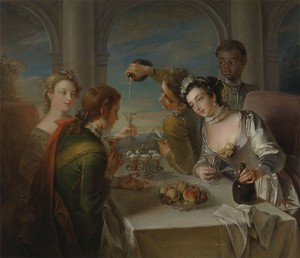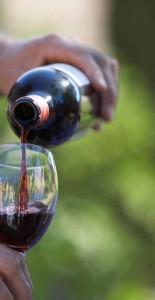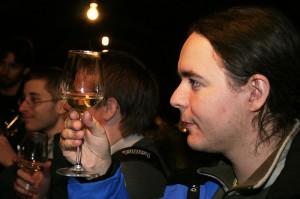What motivates someone to drink has been linked to the amount of alcohol one typically consumes. Previously on The Academic Wino, a study was presented that showed people consuming alcohol for “positive” reasons (such as the taste or the health benefits of the wine) did not typically express problem drinking behaviors, whereas people consuming alcohol for “negative” reasons (such as reducing anxiety, coping with stress, or peer pressure) are much more likely to experience problem drinking behavior.
Some studies have shown that those that are motivated by internal factors, such as drinking to have fun or drinking to forget personal problems, are much more likely to drink more heavily than those that are motivated by external factors, such as drinking to be socialor drinking to fit in with the group. The thinking is that those that are influenced by internal factors will tend to drink not only when
they are with other people, but also when they are all alone, whereas those that are influence by external factors will only tend to drink when in the company of a group of people. To generalize, those influenced by external factors tend to be more moderate drinkers overall than heavy drinkers.To date, nearly all of the studies focused on motivation for drinking have relied upon self-reporting by the participants themselves, a method by which is known to suffer from bias. To be more specific, there could be errors in the self-reporting data due to forgetfulness of past events, as well as guilt or embarrassment by the participant in regards to how much they actually drink on a regular basis.
To combat this issue of bias in self-reporting, the study presented today combined self-reporting with a wine tasting experiment, in order to determine if drinking motives as reported by participants were able to predict the amount of alcohol consumed during the tasting sessions some time later or if the answers supplied by participants inaccurately represented their drinking habits in actual drinking situations.
Methods
Participants were recruited in the fall of 2010 from Lausanne University in Switzerland and were required to be between the ages of 18 and 25, have no significant health problems or history of substance abuse.
Participants filled out a 10 minute questionnaire that asked questions related to sociodemographics as well as alcohol consumption behavior questions.
A total of 123 subjects participated in all experiments during the study.
As an incentive to participate, subjects were entered into a drawing to win the equivalent of $600 USD, were given money to cover the cost of public transportation to the sessions, and were given a snack after each session.
There were a total of 3 data collection sessions: 1) the questionnaire; 2) a first wine tasting session; and 3) a second wine tasting session. There was a total of 1 month in between each session.
Participants were told that the wine tasting experiments were to determine the influence of human interactions on sensory experiences during the tasting.
Wine tasting sessions were held in an area designed to look like a comfortable bar. Participants were asked to refrain from drinking any alcoholic beverages within 12 hours before each wine tasting session.
At the start of each tasting, a research assistant went over standard wine tasting protocol with participants. Participants were each given a spit bucket as well as water. Participants were told that they were not required to swallow the wines they tasted.
During the tasting sessions, participants were given 4 glasses with 110g of red wine. The alcohol level of the wine was 13.5%, which translates to about 12g of alcohol per glass of wine. Each tasting session lasted 25 minutes.
To determine the influence of social context on amount of alcohol consumed, the two tasting sessions were arranged so that either the participants were separated from one another to prevent any interaction or visual contact or they were arranged in groups of 4-8 participants with the ability to interact and be social. In the group setting, discussions were moderated by the research assistant. For each tasting session, men and women were kept separately from one another. Each participant was randomly assigned to a tasting group; in order to (as the authors explained) avoid close friends participating in the same group together.
After the tasting sessions, the amount of wine remaining in the glass for each individual was measured, as well as how much wine was found in the spit buckets for each individual. The amount of wine left in the glasses and in the spit buckets was subtracted from the original amount of wine presented to the participants, and converted to grams of pure alcohol. This value represented the total amount of alcohol consumed per tasting session per individual participant.
Drinking motives, alcohol use, and problem drinking behavior was analyzed and determined using participants’ responses on a questionnaire.Drinking motive categories included: 1) enhancement (i.e. drinking to have fun); 2) coping (i.e. drinking to forget personal problems); 3) social (i.e. drinking to be social among peers); and 4) conformity (i.e. drinking to fit in with the group).
Results
- 45.5% of participants were male, and 54.5% were female.
- The mean age of participants was 21.9 years.
- 17.1% of participants were found to be socially motivated.
- 52.4% of the socially motivated participants were male and 47.6% were female.
- 16.3% of participants were found to be enhancement motivated.
- 55.0% of the enhancement motivated participants were male, and 45% were female.
- 70.6% of the conformity motive participants were female, while 29.4% were male.
- 54.5% of participants claimed they drank two or more times per week.
- 60.2% of participants claimed they drank three or more drinks during a day that they are drinking.
- 35.0% of participants claimed they had 6 or more drinks during a day that they are drinking.
- Participants reporting high quantities of drinking or binge drinking tended to be motivated more by enhancement motives than those drinking for any other motive.
- During the first wine tasting session, an average of 15.6g of alcohol per participant was consumed.
- During the second wine tasting session, an average of 18.8g of alcohol per participant was consumed.
- The tendency to drink more during the second session was most notable among participants drinking for coping reasons.
- Drinking greater amounts of alcohol was associated with high levels of social motivation, as well as a low level of coping or conformity motivation.
- Men reported drinking more frequently and binge drinking more often than women.
- For both tasting sessions, men consumed 22.5g more alcohol than women (on average).
- Men consumed 11g more alcohol than women during the first tasting session, and 11.4g more alcohol during the second tasting session.
- Looking at each tasting session separately, there were no significant differences between the sexes in regards to alcohol consumption (though it was close). Taking both tasting sessions together, men consumed significantly more alcohol than women.
- Those participants starting in the group setting during the tasting sessions consumed 7.9g more alcohol than participants starting in the individual setting.
- Those participants self-reporting as being motivated by enhancement reasons consumed significantly more alcohol than participants reporting other motivations for drinking.
- Those participants self-reporting as being motivated by conformity reasons consumed significantly less alcohol than participants reporting other motivations for drinking.
- The self-reported motivation for drinking could not predict the amount of alcohol consumed during each tasting session individually, however, self-reported motivation for drinking could predict the total amount of alcohol consumed after both tasting sessions.
- From the first tasting session to the second tasting session, coping motivated drinkers significantly increased their alcohol consumption.
- From the first tasting session to the second tasting session, socially motivated drinkers significantly decreased their alcohol consumption.
Conclusions
According to the authors of this study, when taking the amounts of alcohol consumed from both tasting sessions together, the actual amounts of alcohol consumed was very highly correlated with the amounts of alcohol reported by the participants in the questionnaire. In other words, according to these results, motives for drinking allow one to predict the amount of alcohol consumed by an individual in a particular setting.
The authors also stated that those than are motivated by internal reasons (i.e. drinking for enhancement or coping purposes) tend to take advantage of a drinking situation where alcohol is readily available and free. The authors claim that this may be a result of their desire to attain the psychoactive effects of the alcohol itself in order to “maximize pleasurable sensations” or perhaps more readily forget their personal problems. To explain the results of externally motivated participants, the authors surmised that they likely drank lower amounts of alcohol because they tend to be inconsistent in their drinking patterns, and perhaps since they did not know the other people in their tasting groups, they were less likely to drink more.
When looking at the tasting sessions individually, the authors noted that drinking motive could not predict the amount of alcohol consumed per session (particularly the first session). They reason this result to be potentially due to the nature of the experimental design itself. Perhaps since participants were not familiar with the tasting procedure they were asked to do, the location they were performing the tastings in, or the other participants they were paired up to taste with, they were uncomfortable with the situation and less likely to consume the
same levels of alcohol they would have consumed if they were in a more comfortable and familiar environment. This may explain why alcohol consumption increased during the tasting session, since at this point, the participants had a chance to get used to the situation and became more comfortable and familiar with the whole thing.The authors noted some limitations with the study, including the sample size and the way participants actually felt about the wines they were drinking. The study only included only 123 college students between the ages of 19 and 24, which is certainly not representative of the general population. Would older participants when placed in the same situations yield similar results? Or would there be significant differences in drinking motivation and alcohol consumption behavior across generations?
In regards to not testing how the participants felt about the wine they were consuming, I feel as though this could potentially have significant consequences on the overall results (or not…I’m not completely certain). What if a significant proportion of participants don’t drink wine to begin with? They then may not be consuming the amount of alcohol they normally would be under a given situation due to simply not liking beverage used in the study. Perhaps they would drink even more if they had been handed fruity mixed drinks instead of red wine. After all, studied do show that younger individuals drink more of these types of beverages than wine (in general) when compared to their older counterparts.
Overall, the results of this study confirm that self-reported drinking behavior is correlated with the actual amount of alcohol consumed during a wine tasting session. I would be hesitant to say this with complete confidence, mainly based on the limitations I just discussed in the previous two paragraphs. I think the results are interesting and certainly a good start, however, I think these limitations would need to be addressed before I am completely convinced these results to be accurate and reflective upon the general population.
What did you all think of this study? What would you like to have seen differently? Maybe I’m being too harsh regarding the limitations: do you think these limitations are insignificant to the results? Please feel free to comment!
Source: Kuntsche, E., and Kuendig, H. 2012. Beyond Self Reports: Drinking Motives Predict Grams of Consumed Alcohol in Wine-Tasting Sessions. Experimental and Clinical Psychopharmacology 20(4): 318-324.



